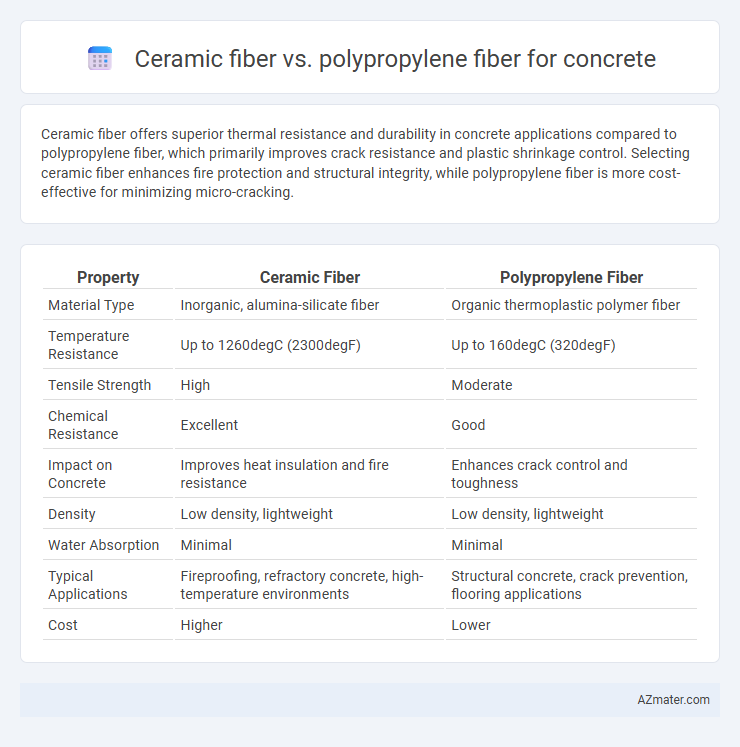Ceramic fiber offers superior thermal resistance and durability in concrete applications compared to polypropylene fiber, which primarily improves crack resistance and plastic shrinkage control. Selecting ceramic fiber enhances fire protection and structural integrity, while polypropylene fiber is more cost-effective for minimizing micro-cracking.
Table of Comparison
| Property | Ceramic Fiber | Polypropylene Fiber |
|---|---|---|
| Material Type | Inorganic, alumina-silicate fiber | Organic thermoplastic polymer fiber |
| Temperature Resistance | Up to 1260degC (2300degF) | Up to 160degC (320degF) |
| Tensile Strength | High | Moderate |
| Chemical Resistance | Excellent | Good |
| Impact on Concrete | Improves heat insulation and fire resistance | Enhances crack control and toughness |
| Density | Low density, lightweight | Low density, lightweight |
| Water Absorption | Minimal | Minimal |
| Typical Applications | Fireproofing, refractory concrete, high-temperature environments | Structural concrete, crack prevention, flooring applications |
| Cost | Higher | Lower |
Introduction to Fiber Reinforcement in Concrete
Fiber reinforcement in concrete enhances structural performance by improving tensile strength, crack resistance, and durability. Ceramic fibers offer high temperature resistance and chemical stability, making them ideal for refractory and high-heat applications, while polypropylene fibers provide lightweight, low-cost reinforcement that reduces shrinkage and improves impact resistance. Selecting between ceramic and polypropylene fibers depends on specific project requirements such as exposure conditions, mechanical performance, and cost efficiency.
Overview of Ceramic Fiber for Concrete
Ceramic fiber in concrete provides exceptional thermal resistance, withstanding temperatures above 1,200degC, making it ideal for refractory applications and high-heat environments. Its low thermal conductivity and excellent insulating properties reduce thermal expansion and cracking, enhancing the durability and structural integrity of concrete under extreme conditions. The high alumina and silica content in ceramic fiber contributes to its chemical stability and resistance to corrosion, improving long-term performance in aggressive environments.
Overview of Polypropylene Fiber for Concrete
Polypropylene fiber for concrete enhances durability by reducing shrinkage cracks and improving impact resistance, making it a cost-effective additive for structural integrity. It offers superior chemical resistance and lightweight properties compared to ceramic fiber, enabling better dispersion and bonding within the concrete matrix. Widely used in industrial, commercial, and residential concrete applications, polypropylene fibers improve toughness and freeze-thaw durability while minimizing corrosion risk.
Mechanical Properties Comparison
Ceramic fiber-reinforced concrete exhibits superior high-temperature resistance and enhanced compressive strength, making it ideal for refractory applications. Polypropylene fiber improves concrete's tensile strength, impact resistance, and crack control but has lower thermal stability compared to ceramic fiber. The choice depends on mechanical property requirements: ceramic fiber offers enhanced durability under extreme heat, whereas polypropylene fiber enhances flexibility and toughness at ambient conditions.
Durability and Longevity Differences
Ceramic fibers offer superior durability and thermal resistance compared to polypropylene fibers, significantly enhancing the longevity of concrete in high-temperature environments. Polypropylene fibers provide excellent crack resistance and improve concrete toughness but degrade faster under prolonged heat exposure, reducing long-term structural integrity. The choice between ceramic and polypropylene fibers directly affects the durability of concrete, especially in applications involving thermal stress and chemical exposure.
Impact on Workability and Mixing
Ceramic fiber in concrete enhances heat resistance but can reduce workability due to its coarse texture and lower flexibility, requiring more water or admixtures to maintain mix consistency. Polypropylene fiber improves workability by dispersing evenly and providing better flow, as its fine, flexible strands reduce segregation and bleeding during mixing. The choice between ceramic and polypropylene fibers significantly affects mixing efficiency and the concrete's ease of placement.
Resistance to Heat and Chemical Attack
Ceramic fiber offers superior resistance to high temperatures up to 1,200degC, making it ideal for concrete applications exposed to intense heat or thermal shock. Polypropylene fiber provides excellent resistance to chemical attack, especially against acids, alkalis, and sulfates, enhancing concrete durability in aggressive environments. For high-heat scenarios, ceramic fiber enhances structural integrity, while polypropylene fibers improve chemical resilience and reduce micro-cracking in concrete.
Cost-Benefit Analysis
Ceramic fiber offers superior heat resistance and durability in concrete applications but comes at a significantly higher cost compared to polypropylene fiber, which provides effective crack control and flexibility at a lower price point. Polypropylene fiber is widely favored for general use in concrete due to its cost-efficiency and ease of integration, whereas ceramic fiber is reserved for specialized high-temperature environments despite its premium price. Evaluating the cost-benefit ratio involves balancing initial material expenses against performance requirements and longevity in specific construction scenarios.
Typical Applications in Construction
Ceramic fibers are predominantly used in refractory and high-temperature concrete applications such as fireproofing, furnace linings, and thermal insulation for industrial structures, offering superior heat resistance and insulation properties. Polypropylene fibers enhance concrete primarily in general construction by improving crack resistance, reducing shrinkage, and increasing durability in slabs, pavements, and precast elements. The choice between ceramic and polypropylene fibers depends on specific performance requirements, with ceramic fibers favored for thermal protection and polypropylene fibers preferred for general reinforcement and durability in standard concrete applications.
Conclusion: Choosing the Right Fiber for Concrete
Ceramic fiber offers excellent high-temperature resistance and superior durability for concrete used in fireproofing and refractory applications, while polypropylene fiber excels in mitigating plastic shrinkage cracks and enhancing concrete toughness at a lower cost. Selecting the appropriate fiber depends on specific project requirements such as thermal resistance, mechanical performance, and budget constraints. For high-performance, heat-exposed concrete, ceramic fiber is ideal, whereas polypropylene fiber suits general structural and curing applications due to its cost-effectiveness and ease of use.

Infographic: Ceramic fiber vs Polypropylene fiber for Concrete
 azmater.com
azmater.com